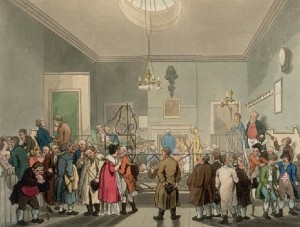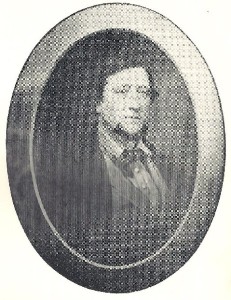
While I can’t claim to have thought of the idea first–Seinfeld was famous for being “a show about nothing,”–I can say that I am proudly writing a book about nothing.
It doesn’t work out so well, it seems, when I try to put too much plot in there. So I am writing a book about a gentleman who succeeds somewhat unexpectedly to a dukedom, and finds that the dukedom comes with a duchess–a woman whose parents have entered into agreements to wed her to the man affiliated with the title, no matter who the man is.
It’s a Marriage of Convenience story, and there’s no big villain, or big misunderstanding, or traumatic life or death issues at stake; merely the happiness of two people who are already relatively comfortable in life, at least in terms of their circumstances.
It’s hard to keep the focus purely on the relationship, but I’m a quarter of the way in, and so far, it seems to be okay. I like stories about nothing but the relationship, although I definitely envy authors who can add plot and not make it seem incredibly lame.
Plot will find its way in somehow, it usually does, but meanwhile, I have two characters who have to come to know one another, trust one another and, eventually, love one another.
What other ‘books about nothing’ have you loved?
For once not talking about Regency clothes but what happens when you take on all of an author’s books in a short period of time. I attended an Austen discussion group recently where someone mentioned, having read four Austen books in a row, that she was tired of “the stuff”–balls, dances, who was going where with whom, and so on.
I’ve been a victim of this recently, reading with great enjoyment [brief digression to dispose of a mosquito the size of my head followed by burial at sea in bathroom] almost all the books in a series of of mysteries set in England, written by an American author.
What does happen [sorry about the mosquito digression] is that you start to notice the nervous tics, minor obsessions etc. of the writer. Unlike Austen, whose “stuff” is the gears that drive the novel, other writers’ “stuff” may be annoying or endearing. This author is fixated on English sandwiches, the sort sold just about everywhere in triangular packages. They are smaller and more compact than their US counterparts with modest but tasty fillings. The closest thing we have here are those sold by Pret A Manger (a chain that originated in London). Yum.
Now that I don’t mind. I’m quite happy to read about food, and possibly, it’s not too intrusive since the characters tend to chow down and discuss the case. What does bug me about this particular author is that every character introduces themselves in this way: “By the way, I’m …” Really? Do English people do that all the time?
Mysteries seem rather vulnerable to “stuff,” particularly kneejerk descriptions of what characters are wearing, even for cameo appearances. Whether it’s a bizarre reader expectation or an editor demanding a description of some sort, it can be distracting. I read a book some decades ago, where the action was halted dramatically by sartorial details–memorably, after a gunman burst through a glass door, we were treated to a description of what he was wearing before the action resumed.
 My own writerly nervous tics include huge amounts of tea drinking, leaning on mantelpieces, heroes in tears, and they’re all there in the revised version of my first book Dedication which I self pubbed a few days ago. Filthy and affordable, what more could you ask for? Buy the Kindle version here.
My own writerly nervous tics include huge amounts of tea drinking, leaning on mantelpieces, heroes in tears, and they’re all there in the revised version of my first book Dedication which I self pubbed a few days ago. Filthy and affordable, what more could you ask for? Buy the Kindle version here.
Are you aware of writerly “stuff” as you read? Does it annoy you or do you just accept it as part of the book?
 This summer I’m starting a new endeavor I may have mentioned before: a new series. I’m not ready to discuss it here yet, because it’s still so shapeless in my mind I can’t quite believe in it. It’s a project that excites me and scares me at the same time, because it’s going to require a lot more research and plotting on a level beyond what I did for my “Three Disgraces” trilogy, which were only loosely connected.
This summer I’m starting a new endeavor I may have mentioned before: a new series. I’m not ready to discuss it here yet, because it’s still so shapeless in my mind I can’t quite believe in it. It’s a project that excites me and scares me at the same time, because it’s going to require a lot more research and plotting on a level beyond what I did for my “Three Disgraces” trilogy, which were only loosely connected.
I hope readers will be patient with me as I take this climb. It looks steep, and after a point, I’m not sure what the path will entail. But there’s also the prospect of some amazing views as I get closer to the end.
So I have ordered some new reference books and stocked up on journals and my favorite pen (G-2 Pilot, in blue, not black), because I do my best brainstorming in longhand. I may also play with some easier side projects (I have several ideas for novellas) to take some of the pressure off.
I’m also taking some time to spiff up how I do ebook formatting. Many thanks to Risky Carolyn Jewel who spent an hour or so patiently answering my questions and gave me some excellent suggestions! Although it is technical work, it’s creative too, and that feeds my muse and it’s fun! (Yes, I am a little bid mad, but harmless, I promise you.)
What do you do to psyche yourselves up for a big project?
Elena
www.elenagreene.com
I’m so excited to welcome today’s guest blogger to the Riskies! Sheri Cobb South is the author of the fabulous Regency-set John Pickett mysteries. One commenter will win a signed ARC of her newest title, Family Plot….
 In many ways, the history of London’s Bow Street force is too complex to be covered adequately in a blog. Whole books could be written—and have been—about this 18th century precursor to Scotland Yard. In his introduction to Henry Goddard’s Memoirs of a Bow Street Runner (William Morrow and Company, 1949), Patrick Pringle notes the lack of contemporary sources, almost all the official records having been destroyed in 1881, when the Bow Street Police Office moved from its original site adjacent to Covent Garden Theatre across the street to the site where the Bow Street Magistrate’s Court building may still be seen.
In many ways, the history of London’s Bow Street force is too complex to be covered adequately in a blog. Whole books could be written—and have been—about this 18th century precursor to Scotland Yard. In his introduction to Henry Goddard’s Memoirs of a Bow Street Runner (William Morrow and Company, 1949), Patrick Pringle notes the lack of contemporary sources, almost all the official records having been destroyed in 1881, when the Bow Street Police Office moved from its original site adjacent to Covent Garden Theatre across the street to the site where the Bow Street Magistrate’s Court building may still be seen.
 Still, certain factoids concerning the Bow Street force—their red waistcoats, for instance—turn up again and again in novels, assumed by authors to be accurate by their very ubiquitousness; this was certainly my own view when I set out to create Bow Street Runner John Pickett and his world for my mystery series. But when I discovered the aforementioned Memoirs, published by Goddard’s grandson’s widow from his notebooks, I realized that many of the things I thought I knew about Bow Street were wrong.
Still, certain factoids concerning the Bow Street force—their red waistcoats, for instance—turn up again and again in novels, assumed by authors to be accurate by their very ubiquitousness; this was certainly my own view when I set out to create Bow Street Runner John Pickett and his world for my mystery series. But when I discovered the aforementioned Memoirs, published by Goddard’s grandson’s widow from his notebooks, I realized that many of the things I thought I knew about Bow Street were wrong.
Take those red waistcoats, for instance. They are accurate to a point; the Horse Patrol wore them, as did, later, the foot patrol. But the Runners were always a plainclothes force, and very deliberately so: the independent English mind had a horror of the kind of martial law found in European countries, and Bow Street founder Henry Fielding (he of Tom Jones fame) had the wisdom to know that anything resembling a uniform was to be avoided. Even when the Horse Patrol costume was standardized half a century later, in 1805, every care was taken to be sure that their blue coats and red waistcoats looked as much like civilian dress as possible.
Nor was everyone on the Bow Street force created equal—and not everyone was a Runner. The members of the Foot Patrol worked at night, and earned the lowest wages at half a crown—two and a half shillings—a day. As one might expect, this bottom rung of the ladder was where many eventual Runners started out, including memoirist Henry Goddard. He enlisted in the Foot Patrol in 1824, five years before Robert Peel’s Metropolitan Police would begin to encroach upon the Runners’ territory. Within a year or two Goddard was promoted to the Day Patrol at a salary of three shillings and sixpence per day. Finally he rose to the position of principal officer—those individuals we know as Runners. (He was twenty-six years old at the time, which told me I was not too far afield in letting my precocious young John Pickett achieve that position at age twenty-three.)
Bow Street Runners were paid twenty-five shillings a week, but they had other ways of supplementing their income. The first of these was by private commission on behalf of anyone who was able to pay them. The fee for their services was usually a guinea a day and, if the case should take them beyond London, fourteen shillings a day for travel expenses, including meals and lodging. If the case was successful, a reward would be paid as well.
Another, more controversial, income stream derived from the longstanding practice of offering payment for convictions. As one might imagine, such a system invited corruption, which had reached its peak (or perhaps its nadir) with the 18th century “Thief-Taker General” Jonathan Wild, who enticed the young and/or gullible into committing crimes so that he might collect rewards for bringing them to justice. Although Wild was hanged for his crimes almost a quarter-century before Fielding’s establishment of the Bow Street Runners, his memory still lived in the public consciousness, and even in death he managed to blacken the reputation of a Bow Street force which operated under a very similar system.
 While the creation of the Metropolitan Police in 1829 marked a change in law enforcement in what was the most populous city in the world at the time, it did not mean the immediate end of the Bow Street Runners. They continued in their role of detectives, and their civilian dress gave them advantages over the uniformed—and consequently more conspicuous—New Police. It was not until 1839, ninety years after their founding, that the Bow Street Runners ceased to exist. Even so, Henry Goddard continued to operate as a private detective as late as 1856, and very likely longer.
While the creation of the Metropolitan Police in 1829 marked a change in law enforcement in what was the most populous city in the world at the time, it did not mean the immediate end of the Bow Street Runners. They continued in their role of detectives, and their civilian dress gave them advantages over the uniformed—and consequently more conspicuous—New Police. It was not until 1839, ninety years after their founding, that the Bow Street Runners ceased to exist. Even so, Henry Goddard continued to operate as a private detective as late as 1856, and very likely longer.
In addition to giving us an insiders’ look at the sort of cases a Bow Street Runner might be called upon to investigate, Goddard’s Memoirs offer a glimpse of the birth of modern forensics. In one of his cases, for example, he recalls his discovery that the balls fired from a particular gun left holes of a distinctive shape—a circumstance that allowed him to identify the exact weapon used.
Memoirs of a Bow Street Runner is out of print today, but might still be found through interlibrary loan or used-book sites such as www.bookfinder.com.